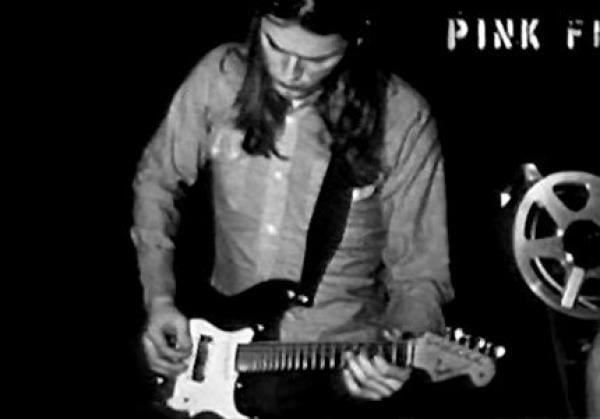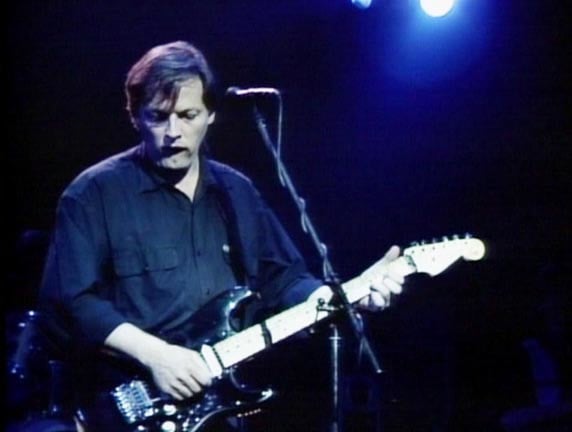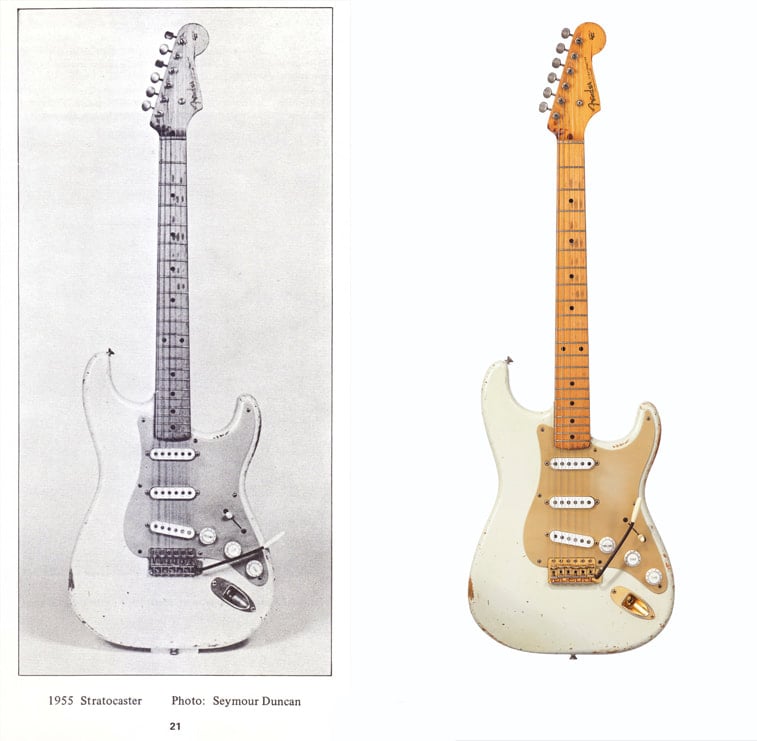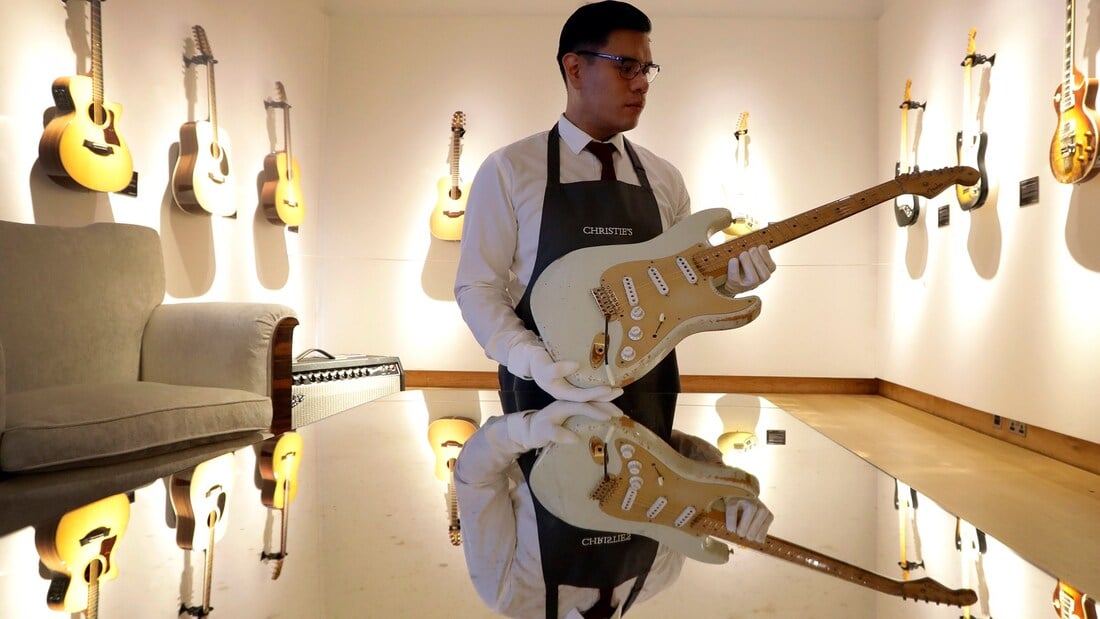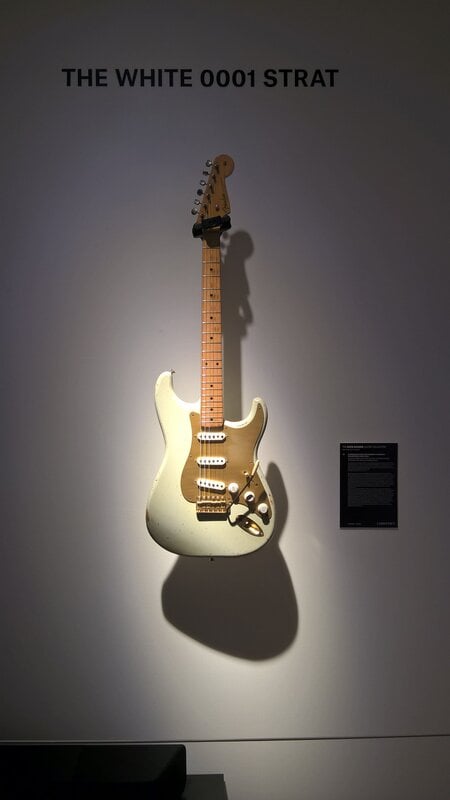In the summer of 2008 one of the most anticipated Stratocasters of all time appeared in the Custom Shop catalog, the David Gilmour Signature Stratocaster, inspired by the famous Black Strat of the renowned Pink Floyd guitarist, and born thanks to an intense collaboration between Fender and the historic musician’s technician, Phil Taylor.
David’s Black Strat is a 1969 black over sunburst Fender Stratocaster with big headstock, maple neck, black pickguard and white single coil pickup covers, which was used for recording Live at Pompeii and many songs of The Dark Side of The Moon, Wish You Were Here, Animals, The Wall and Gilmour’s solo album, On an Island.
David’s Black Strat is a 1969 black over sunburst Fender Stratocaster with big headstock, maple neck, black pickguard and white single coil pickup covers, which was used for recording Live at Pompeii and many songs of The Dark Side of The Moon, Wish You Were Here, Animals, The Wall and Gilmour’s solo album, On an Island.
THE ORIGINAL BLACK STRAT
The Black Strat was purchased by David Gilmour to replace a black Stratocaster with a rosewood fretboard that he acquired just six weeks earlier, during the 1970 American tour, which was stolen along with the group's other equipment.
Consequently, the guitarist went to Manny's store of Manny Goldrich, New York, to buy an identical one. As the black finish was not available any more, he chose a Stratocaster with a custom black finish sprayed over sunburst and a maple neck.
Consequently, the guitarist went to Manny's store of Manny Goldrich, New York, to buy an identical one. As the black finish was not available any more, he chose a Stratocaster with a custom black finish sprayed over sunburst and a maple neck.
The new guitar, which David played for the first time in public at the Bath Festival in June 1970, is almost as legendary as its owner. From the photos and videos made over the years it is possible to notice how the original Black Strat has undergone, little by little, important changes.
In 1972 David replaced the Fender Keys of the original neck with Kluson tuning machines. Then he replaced the original one piece maple neck with one with a rosewood fretboard, taken from a 1963 Stratocaster that, in turn, had been taken from a ’59 strat. This neck was swapped out for a custom Charvel bird's eye maple neck ahead of recording sessions for The Wall, in 1979. This neck had a Fender logo and 21 frets. In 1982 he replaced this neck with a custom Charvel 22 fret birdseye maple neck for the recordings of The Final Cut, enabling him to reach a semitone higher at the top end. This neck also featured a Fender logo. Then, according to Gilmourish, he used three ’57 Vintage reissue necks: in early 2003, when the Black Strat featured a '57 reissue maple neck with the "ORIGINAL Contour Body" decal on the ball of the headstock for a BBC documentary; between late 2003 and early 2004, when the guitar was exhibited at the Interstellar Exhibition, in Paris, with a second '57 reissue maple neck, recognizable for the lack of the "ORIGINAL Contour Body" decal. Then, prior to recording On An Island, the Black Strat received its current 1983 neck from Gilmour’s '57 Vintage reissue dubbed Cream Strat.
David also made major modification to the electronics and pickups over the years. In 1973, for a very short time, a Gibson PAF humbucker appeared between the pickup at the bridge and that at the mid. Then, returned to the classic SSS configuration, the pickup at the bridge was replaced first with a Di Marzio FS-1 with black cover, and subsequently with a custom wound Seymour Duncan SSL-1C.
In 1972 Gilmour added an edge-mounted XLR socket: “At one point I drilled a big hole to put one of those big XLR things on it because I wanted to have the sound coming out of the guitar, going out through a pedal board, coming back into the guitar and going through a volume knob again. That didn’t last terribly long so I made some paste out of sawdust and wood glue and filled it back in again.” The repair work is still very much visible on the guitar today.
In the same year, David also installed a mini switch on the pickguard to activate the neck/bridge pickups combination with the purpose of obtaining a sound similar to that of the Jazzmaster: “There’s a sound on a Jazzmaster which you get by having your bridge pickup and your neck pickup on at the same time. Now, on a Strat because you’ve got a middle pickup, the switch doesn’t do that. So I got a little piece of metal in a U-shape and glued it on to the underside and drilled a little hole and put a little switch in, and that switch switches on this pickup, which creates a sound a bit like the Jazzmaster. That was one of the experiments that I did that I still have.” This switch, in "the PAF period", was used for the activation of the humbucker. In 1985, David replaced the 3-way selector with a 5-position one.
Other important changes concerned the use of a thick custom beveled black pickguard in 1974 and a shorter (4.25") tremolo bar, in 1984, to allow more control when playing: “I just one day took a hacksaw to it and cut it off and stuck the plastic bit back on the end of it. It suits me - I’ve found it much more useful and it’s helped to create a style, I guess.”
In 1983 David even replaced original bridge with a Kahler tremolo system with locking tuners that, due to its dimensions, forced the guitarist to rout the Stratocaster body slightly. The addition of the Kahler tremolo was less successful as it altered the sound of the guitar, so, in 1997, David wanted to come back to the original bridge, and sent the guitar to Charlie Chandler for restoration. The luthier had to fill, as far as possible, the cavity left by the Kahler tremolo.
The Black Strat was sold at Christie's, one of the most famous auction houses in the world, on June 20, 2019 at the modest price of $3.300.000, together with many instruments of David Gilmour, who had donated the proceeds to charity.
In 1972 David replaced the Fender Keys of the original neck with Kluson tuning machines. Then he replaced the original one piece maple neck with one with a rosewood fretboard, taken from a 1963 Stratocaster that, in turn, had been taken from a ’59 strat. This neck was swapped out for a custom Charvel bird's eye maple neck ahead of recording sessions for The Wall, in 1979. This neck had a Fender logo and 21 frets. In 1982 he replaced this neck with a custom Charvel 22 fret birdseye maple neck for the recordings of The Final Cut, enabling him to reach a semitone higher at the top end. This neck also featured a Fender logo. Then, according to Gilmourish, he used three ’57 Vintage reissue necks: in early 2003, when the Black Strat featured a '57 reissue maple neck with the "ORIGINAL Contour Body" decal on the ball of the headstock for a BBC documentary; between late 2003 and early 2004, when the guitar was exhibited at the Interstellar Exhibition, in Paris, with a second '57 reissue maple neck, recognizable for the lack of the "ORIGINAL Contour Body" decal. Then, prior to recording On An Island, the Black Strat received its current 1983 neck from Gilmour’s '57 Vintage reissue dubbed Cream Strat.
David also made major modification to the electronics and pickups over the years. In 1973, for a very short time, a Gibson PAF humbucker appeared between the pickup at the bridge and that at the mid. Then, returned to the classic SSS configuration, the pickup at the bridge was replaced first with a Di Marzio FS-1 with black cover, and subsequently with a custom wound Seymour Duncan SSL-1C.
In 1972 Gilmour added an edge-mounted XLR socket: “At one point I drilled a big hole to put one of those big XLR things on it because I wanted to have the sound coming out of the guitar, going out through a pedal board, coming back into the guitar and going through a volume knob again. That didn’t last terribly long so I made some paste out of sawdust and wood glue and filled it back in again.” The repair work is still very much visible on the guitar today.
In the same year, David also installed a mini switch on the pickguard to activate the neck/bridge pickups combination with the purpose of obtaining a sound similar to that of the Jazzmaster: “There’s a sound on a Jazzmaster which you get by having your bridge pickup and your neck pickup on at the same time. Now, on a Strat because you’ve got a middle pickup, the switch doesn’t do that. So I got a little piece of metal in a U-shape and glued it on to the underside and drilled a little hole and put a little switch in, and that switch switches on this pickup, which creates a sound a bit like the Jazzmaster. That was one of the experiments that I did that I still have.” This switch, in "the PAF period", was used for the activation of the humbucker. In 1985, David replaced the 3-way selector with a 5-position one.
Other important changes concerned the use of a thick custom beveled black pickguard in 1974 and a shorter (4.25") tremolo bar, in 1984, to allow more control when playing: “I just one day took a hacksaw to it and cut it off and stuck the plastic bit back on the end of it. It suits me - I’ve found it much more useful and it’s helped to create a style, I guess.”
In 1983 David even replaced original bridge with a Kahler tremolo system with locking tuners that, due to its dimensions, forced the guitarist to rout the Stratocaster body slightly. The addition of the Kahler tremolo was less successful as it altered the sound of the guitar, so, in 1997, David wanted to come back to the original bridge, and sent the guitar to Charlie Chandler for restoration. The luthier had to fill, as far as possible, the cavity left by the Kahler tremolo.
The Black Strat was sold at Christie's, one of the most famous auction houses in the world, on June 20, 2019 at the modest price of $3.300.000, together with many instruments of David Gilmour, who had donated the proceeds to charity.
The David Glimour Signature Stratocaster
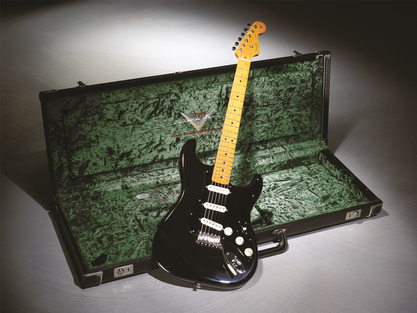
In the autumn of 2006, Mike Eldred and Todd Krause met Phil Taylor in London to lay the foundations of a signature based on the Black Strat and capture the measurements and specific details of the original guitar, from which the first prototype would be made. Over the next two years, three more prototypes would be produced and five different pickup configurations were tested and refined with Gilmour’s participation.
If, on the one hand Phil insisted that the guitar had to be replicated in details, thus determining repercussions on the final price of the guitar, on the other Gilmour would have preferred an instrument, although expensive, within everyone's reach, but he was very particular about replicating the pickups' sound and the tremolo set-up.
After at least two years of discussions and rejected prototypes, once the fifth and final prototypes were approved by Gilmour, Custom Shop unveiled the David Gilmour Signature Stratocaster in the summer of 2008. “They've done a fantastically good job to make it as good as I wanted it to be. We've worked quite hard on it, it's taken a while for us to get every part of it dead right,” Gilmour declared.
The guitar went into production and was released in September to coincide with the release of David Gilmour's 3-disc Live in Gdańsk CD/DVD set and was available in two NOS finishes, Black color, and Relic, Black over Sunburst. However there were a number of superficial inaccuracies remaining in comparison to the original guitar, such as the body contours: “The Relic version looks a lot like David's guitar, but we didn't do the maniacal level of detail you see on a Tribute, where we duplicate every microscopic scratch and ding,” said Mike Eldred. David was really excited: “I have some final prototypes of the two different versions, and they are brilliant. In my opinion, they are just as good as my Black Strat, if not better, and I would have no hesitation about using them on a gig. In fact, I used the NOS model when I did an Atom Heart Mother show recently.”
The maple neck of the Custom Shop “Black Strat” resembled that of David Gilmour’s 1983 ’57 Vintage neck, with 21 frets and 7.25" radius. At the bridge it featured a Seymour Duncan SSL5, at the neck a Custom Wound Fat '50, and at the mid a Custom Wound single coil (in the first models a Custom ’69). Obviously, the tremolo bar was shorter and on the thick black pickguard a switch activating the pickup at the bridge in the 1, 2 and 3 positions stood out.
If, on the one hand Phil insisted that the guitar had to be replicated in details, thus determining repercussions on the final price of the guitar, on the other Gilmour would have preferred an instrument, although expensive, within everyone's reach, but he was very particular about replicating the pickups' sound and the tremolo set-up.
After at least two years of discussions and rejected prototypes, once the fifth and final prototypes were approved by Gilmour, Custom Shop unveiled the David Gilmour Signature Stratocaster in the summer of 2008. “They've done a fantastically good job to make it as good as I wanted it to be. We've worked quite hard on it, it's taken a while for us to get every part of it dead right,” Gilmour declared.
The guitar went into production and was released in September to coincide with the release of David Gilmour's 3-disc Live in Gdańsk CD/DVD set and was available in two NOS finishes, Black color, and Relic, Black over Sunburst. However there were a number of superficial inaccuracies remaining in comparison to the original guitar, such as the body contours: “The Relic version looks a lot like David's guitar, but we didn't do the maniacal level of detail you see on a Tribute, where we duplicate every microscopic scratch and ding,” said Mike Eldred. David was really excited: “I have some final prototypes of the two different versions, and they are brilliant. In my opinion, they are just as good as my Black Strat, if not better, and I would have no hesitation about using them on a gig. In fact, I used the NOS model when I did an Atom Heart Mother show recently.”
The maple neck of the Custom Shop “Black Strat” resembled that of David Gilmour’s 1983 ’57 Vintage neck, with 21 frets and 7.25" radius. At the bridge it featured a Seymour Duncan SSL5, at the neck a Custom Wound Fat '50, and at the mid a Custom Wound single coil (in the first models a Custom ’69). Obviously, the tremolo bar was shorter and on the thick black pickguard a switch activating the pickup at the bridge in the 1, 2 and 3 positions stood out.
The 0001 stratocaster
 Gilmour with the White Strat at the 50th anniversary Stratocaster concert
Gilmour with the White Strat at the 50th anniversary Stratocaster concert
One of the most controversial guitars in history is the “White Strat” with the “0001” serial number, played by David Gilmour at the 50th anniversary Stratocaster concert on September 24, 2004 at Wembley Stadium. Apparently the guitar featured a sort of Desert Sand finish with anodized aluminum pickguard and gold hardware. It has been played in other live concerts and has been used for many recordings, including the rhythm guitar on Another Brick in the Wall (Part 2), which was recorded by plugging the White Strat straight into the mixing console.
According to Karl Dallas of Melody Maker, David bought the guitar in 1978 directly from Phil Taylor, who had to buy a house, as Gilmour told him in 1981: “Eventually Phil wanted to borrow some money to buy a house, so I blackmailed him! I said the only way I’d lend him the money to buy the house, was if he sold me the white Strat.” One thing is certain: contrary to what one might believe, it wasn’t certainly the first Stratocaster in history. It is common opinion that it was one of the “pre-production” Stratocasters selected by Leo Fender and given to some endorsers who would help him build the Fender brand. In about 1955 the Stratocaster 0001 was given to Rex Gallion, a guitarist who had assisted Leo with the development of the Stratocaster; according to Rex's brother, Von Gallion, this guitar left the possession of the Gallions when it was traded to a Santa Maria music store known as Sousa Music. Later, in 1966, the White Strat came into the possession of Richard Hoxie Green, a young guitar student from Nipomo, California.
However, an aura of mystery surrounds the history of this instrument.
According to Karl Dallas of Melody Maker, David bought the guitar in 1978 directly from Phil Taylor, who had to buy a house, as Gilmour told him in 1981: “Eventually Phil wanted to borrow some money to buy a house, so I blackmailed him! I said the only way I’d lend him the money to buy the house, was if he sold me the white Strat.” One thing is certain: contrary to what one might believe, it wasn’t certainly the first Stratocaster in history. It is common opinion that it was one of the “pre-production” Stratocasters selected by Leo Fender and given to some endorsers who would help him build the Fender brand. In about 1955 the Stratocaster 0001 was given to Rex Gallion, a guitarist who had assisted Leo with the development of the Stratocaster; according to Rex's brother, Von Gallion, this guitar left the possession of the Gallions when it was traded to a Santa Maria music store known as Sousa Music. Later, in 1966, the White Strat came into the possession of Richard Hoxie Green, a young guitar student from Nipomo, California.
However, an aura of mystery surrounds the history of this instrument.
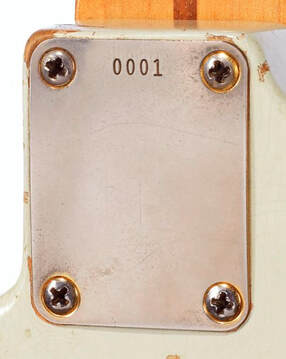
Seymour Duncan says that there are two Stratocasters with serial number 0001. Seymour tells that before starting his long career as pickup maker, he repaired guitars at Jensen's Music in Santa Barbara. In 1976 Richard Green brought him a 1957 Stratocaster with ash body and neck plate stamped with the 0001 serial number in order to repair it and refinish the body with a transparent finish like that of Bonnie Raitt’s guitar. Seymour sent the neck to Phil Kubicki to have it repainted and the body to his friend and colleague Wayne Charvel, Fender authorized repairer: however, as it had scratches and dings that were too deep for a transparent finish, Wayne preferred to replace the body with a new one, a quite widespread practice in the '70s. Seymour reassembled the guitar and returned it to Richard. Sometime later, Seymour was visiting Wayne’s shop, recognized the original body and bought it back to assemble it with a '57 neck and pickups made by him. This Stratocaster also featured the serial number 0001 on the neck plate; but, according to Duncan, neither of the two neck plates was original. Seymour later sold this guitar to Pete Townshend's engineer Alan Rogan, who in turn sold it to Phil Taylor. Richard Green’s guitar was stolen.
However David Mead, who inspected the instrument, states, in an article that appeared in 1995 on Guitarist, that the body was signed "Mary" (Mary Lemus) and dated 9-28-54, while the neck was dated June 1954 and bore Tadeo Gomez’s initials. According to David, the pickups seemed to be 1954 original Fender, while the finish, that looked like a faded Olympic White, had blue / green hue (and so, probably, the guitar was born as a Sonic Blue, color which was therefore almost completely faded). Many credit David Mead, and are convinced that Seymour Duncan is confused with another of the Fenders he dismantled and reassembled.
But at this point the mystery deepens because this guitar also appeared in the book “The Fender Guitar” written by Ken Achard in 1977. This book collected many black and white photos of pre-CBS Stratocasters, including one made by Seymour of a guitar dated 1955 by him. Looking at the guitar we understand that it is Gilmour's! A printing error in the date or a dating error by Duncan?
Fender never made an official replica: “My holy grail was the David Gilmour Strat,” Fender CEO Andy Mooney said. “I tried to convince David for many years to at least give me access to it so we could do some Custom Shop replicas but he was never willing to do it.”
However, in 2013, former Master Builder Fred Stuart (he had left the Custom Shop in 2001), had built a replica of the White Strat, which was sold for $ 93,750 at Christie's in New York on June 20, 2019 (lot number 21), immediately after the original 0001 Stratocaster (lot number 20), sold for $ 1,815,000 during the Gilmour guitar auction in which the Black Strat was also sold. Also Andy Mooney tried - and failed - to buy the 0001 Stratocaster when it was auctioned at Christie's: “I bid on it actually.” Andy said. “I played it at Christie’s when they put it on a roadshow along with his black Strat. So at least I got to touch it and play it, but sadly that one will never make it into the collection!”
However, in 2013, former Master Builder Fred Stuart (he had left the Custom Shop in 2001), had built a replica of the White Strat, which was sold for $ 93,750 at Christie's in New York on June 20, 2019 (lot number 21), immediately after the original 0001 Stratocaster (lot number 20), sold for $ 1,815,000 during the Gilmour guitar auction in which the Black Strat was also sold. Also Andy Mooney tried - and failed - to buy the 0001 Stratocaster when it was auctioned at Christie's: “I bid on it actually.” Andy said. “I played it at Christie’s when they put it on a roadshow along with his black Strat. So at least I got to touch it and play it, but sadly that one will never make it into the collection!”
Antonio Calvosa



